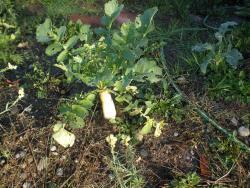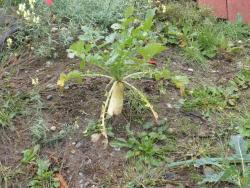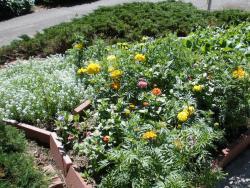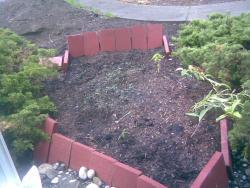Hi Tim.
>> hard like dried clay.
My first guess is "not much". In theory, look for vegetables that can stand "very poor drainage" and "very heavy clay soil" and hot dry climates. But are there any such? I think you'll have to improve your clay or buy or make soil "from scratch" then grow in containers or raised beds.
Hot dry air, especially with wind, means vegetables will need to be able to take up lots of water to stay alive. But clay defeats roots by excluding air. They suffocate (or "drown") when they try to live in damp clay.
Drainage is part of the answer., like finding a gradual slope you can exploit. Butthe soil itself has to improve. There are fast expensive ways and slow cheap ways that take a lot of work. Top-dressing with SOME compost and then using cover crops is a very slow, very cheap way that might be th3e easiest solution for growing actually IN the ground.
I started with heavy clay, but had to fix it up by amending it with lots of compost. (I also added shredded bark, sand and grit, but mostly you need tons of compost or almost anything organic.)
If you can get free leaves, coffee grounds, shredded paper, sawdust, kitchen scraps, rotten fruit from fruit stands, animal manure or "biosolids" from a treatment plant, you can turn that sterile, anaerobic, poorly-draining clay into fertile soil.
One trick is to amend only the top inch or even a layer that sits on TOP of the clay. grow cover crops in that "lasagna layer" and let their roots break up the clay underneath. That might take more than one year, but it is the easiest and cheapest way to beat clay.
Probably the best cover crop for your region is whatever local feed stores sell the most of. Fall rye, buckwheat, vetch, cow peas, alfalfa, timothy, clover or most likely a mix.
I read about "tillage radishes" being able to drill their own holes right into hard clay, so i tried some "Daikon radishes". They went to seed, and now I get some amazing volunteers right on hard clay. of course, sometimes the radish wins, and sometimes the clay wins. I think this one is a tie:
(Once you double-click on one photo, you can see allt he rest by using the right-arrow at the bottom of the photo. "ESC" gets you back to the text.)



Another trick is growing veggies in 4-6 gallon pots, where you make the soil yourself one cubic foot at a time. In the "Edibles and Preserving Forum",
@Newyorkrita turned her driveway into the Garden of Eden or a Horn of Plenty. Your clay can't be MUCH worse than her blacktop driveway!
My preferred way to deal with awful soil is to set up 8" walls, then dig down 8" with pick and mattock, then build it up 8" above grade with a raised bed. I screen rocks out of my clay and break it up with a screen. I add manure, compost, sand and bark. LOTS! The soil is still awful for a year or two, but I keep adding compost, tilling, and growing whatever I CAN grow, and "inoculate" each new bed with soil from my best bed, to bring in beneficial soil microorganisms. The leftover roots each year contribute more organic matter than the compost I could make or afford to buy.
After several years of that, I only till every 3rd year or so, but still have to add compost every year, even if I only scratch it into the top 4". Others just lay compost on top once or twice each year, "and let the worms work it in".
I used concrete paving stones as the cheapest, easiest way to make raised bed walls that won't ever rot (I have 8 months per year of drizzle and fog).



Good luck with your clay! I hope you aren't daunted, and keep coming back to tell us how you found sources of compost and triumphed over gardening adversity.











